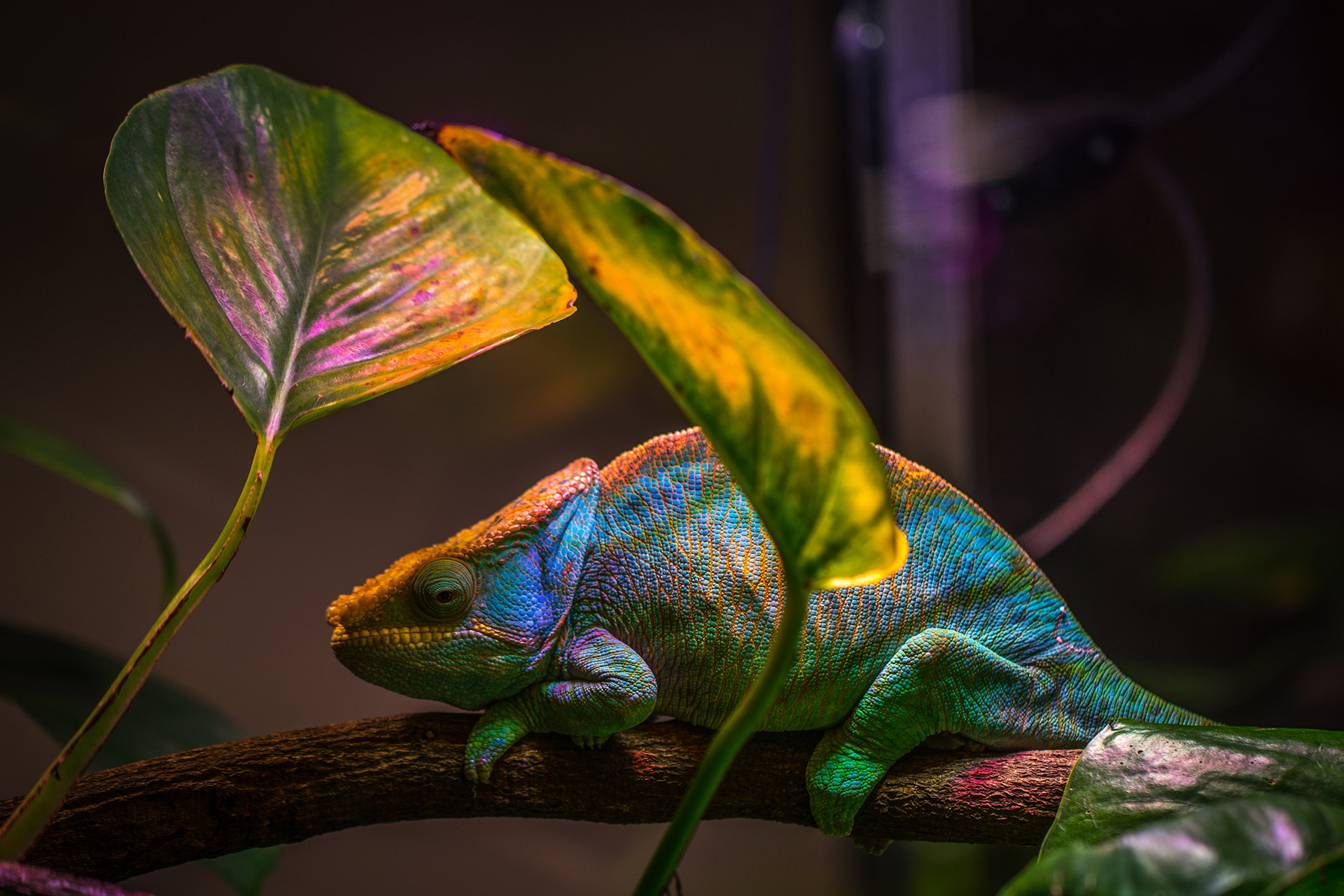Masters of Transformation: Color-Changing Animals
By Roshni Printer

Introduction
Amidst the myriad of phenomena that animals exhibit – from mimicry, hibernation, to bioluminescence – one of the most fascinating is the ability of some animals to change their colors in the blink of an eye. As a result, they can hide from predators, communicate with peers, intimidate when threatened, and regulate body temperature.
How Do Animals Change Color?
The process by which animals change color involves specialized cells called chromatophores. Located in the skin, they are colored cells that contain pigments or photonic structures [1]. Pigments absorb specific wavelengths of visible light and reflect those that are not absorbed, resulting in the colors we see. There are various types of pigment-containing chromatophores, named according to their color: melanophores for black or dark brown, cyanophores for blue, xanthophores for yellow chromatophores, and so on. In addition to pigmentary colors, there are structural colors created by a different mechanism. Iridophores in fish, amphibians and reptiles are made up of transparent guanine nanocrystals [2] that function to interfere with the light reflected off the skin at certain frequencies [3]. Iridophores can also produce iridescence, in which the color appears to change depending on the viewing angle [1].
Chameleons
Chameleons are commonly known for being the representatives of color-changing animals. While most animals can change their color by controlling the dispersion and aggregation of chromatophores, chameleons have an additional level of control with two overlaying sets of iridophores [2]. The upper layer contains regularly arranged guanine nanocrystals. For panther chameleons, they can change their skin color by increasing the distance between these tiny crystals to manipulate the interference of light, leading to the reflection of longer wavelengths from blue to red. In the background of yellow xanthophores, the skin color of a male panther chameleon can thus change from green to yellow or orange when it is excited in male contests or courtship.
The lower layer contains disordered guanine crystals of high reflectivity in the near-infrared region (700–1,400 nm). It provides passive thermal protection to chameleons by reflecting direct and indirect “heat radiations” from the sun back into the environment, thus lowering their body temperature in the dry and sunny habitat.
Mimic Octopus
While chameleons have been the fascination of scientists for decades, the mimic octopus takes the art of adaptation to complex new heights. Among the diverse species of octopus, Thaumoctopus mimicus stands out for its remarkable mimicry skills, through a combination of sophisticated body movements and dynamic skin patterning [4]. The color-changing properties of the mimic octopus is enabled by the fine control over its chromatophores and iridophores [1]. Surrounded by radial muscles, their chromatophores expand upon muscle contraction, increasing the area of exposure of the pigment, hence displaying a more intense skin color. Similar to chameleons, cephalopods also possess iridophores to modify their skin color through optical interference. By modifying the arrangement and molecular structure of reflectin proteins and expulsing water out of the cell, iridophores can be turned “on” and “off” as both actions can change their optical properties [1]. By selectively activating different groups of chromatophores and iridophores to mix different colors, the mimic octopus can accurately mimic the patterns of its surroundings, and change its morphology to imitate a wide variety of marine animals like flatfish, lionfish, and banded sea-snakes [4].
In addition to chromatophores, the mimic octopus also utilizes other specialized skin cells called papillae to enhance its mimicry [5]. These papillae are small muscular structures that can change the three-dimensional texture of the octopus’s skin, providing an added layer of deception.
Conclusion
The study of color-changing abilities in animals such as chameleons and octopuses, highlights the intricate mechanisms and adaptations in nature. Through studying these processes, we gain insight into the strategies of animal survival and communication, enhancing our knowledge and awareness of the value of biodiversity.
References
[1] Figon, F., & Casas, J. (2018, August 24). Morphological and Physiological Colour Changes in the Animal Kingdom. In H. Kehrer-Sawatzki (Ed.), Encyclopedia of Life Sciences. Wiley. https://onlinelibrary.wiley.com/doi/10.1002/9780470015902.a0028065#pane-pcw-references
[2] Teyssier, J., Saenko, S. V., van der Marel, D., & Milinkovitch, M. C. (2015). Photonic crystals cause active colour change in chameleons. Nature Communications, 6, 6368. https://doi.org/10.1038/ncomms7368
[3] Manoharan, V. N. (n.d.). Structural color. Manoharan Lab. https://manoharan.seas.harvard.edu/structural-color
[4] Ureña Gómez-Moreno, J. M. (2019). The ‘Mimic’ or ‘Mimetic’ Octopus? A Cognitive-Semiotic Study of Mimicry and Deception in Thaumoctopus Mimicus. Biosemiotics, 12, 441–467. https://doi.org/10.1007/s12304-019-09362-y
[5] Hanlon, R., Vecchione, M., Allcock, L. (2018). Octopus, Squid, and Cuttlefish: a Visual, Scientific Guide to the Oceans’ Most Advanced Invertebrates. The University of Chicago Press. https://doi.org/10.7208/9780226459738